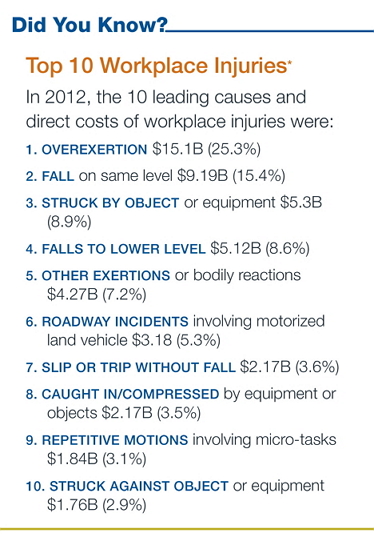Minimizing the risk of overexertion and falls on the same level
Overexertion
and falls on the same level account for more than 40% of the top 10 workplace
injuries in 2012 (the most recent year for which data is available) and cost
companies as much as $25 billion that year, according to the Liberty Mutual Workplace Safety Index 2014.
And yet, with a little extra effort and consideration, employers can take steps
to minimize their risk.
Overexertion
An overexertion
injury is cumulative in nature and results from long term wear and tear on the
musculoskeletal system. Work conditions often only contribute to the injury and
are not typically 100% responsible for it, making it difficult for everyone –
from business owners, supervisors, claims representatives and insurance carriers
as well as the employee themselves-- to determine the injury’s root cause.
“Not being
able to see the injury and not being able to identify a specific point in time
when the injury occurred makes it very difficult for the employee and employer
to determine where the incident really happened and to understand if the injury
was sustained in the course of the work day,” said Thomas Heebner, CSP, ARM,
ABCP, CLCS, senior vice president, Risk Services Division, HUB International.
“There may have been a specific point in time when the employee felt the
injury, but it can be difficult to quantify where the responsibility lies..”
In order to prevent these overexertion injuries from having a negative
effect on your workforce, it’s important to take the following multi-faceted
approach:
1. Focus on pre-hire
qualifications. Hire a third party to perform physical and functional
capacity evaluations and assess the physical abilities and requirements of each
job. Once these are solidified, qualify potential employees to make sure they
can meet the demands of the job.
2. Make work
conditions as safe as possible. Provide tools to make the job as easy as
possible, including designing the workplace so employees of all sizes can work
with good posture to avoid excess stress to their musculoskeletal system. Try
to provide as much flexibility as possible in a fixed workstation so your
employee population can work in a neutral and comfortable posture.
3.
Maintain a healthy workforce. A fit
and healthy employee is less likely to have an overexertion injury and will
recover faster should they sustain an injury than an employee that is unfit
and unhealthy. An unhealthy workforce will drive up the costs of employee care.
Falls
on the same level
Often times an employer doesn’t have
complete control over the work environment. Ice, water or other liquid spills
can increase the risk of falls. Or, a fall could happen outside in the parking
lot while a customer is getting out of their vehicle. There are a few ways
businesses can protect their employees and business associates from this
workplace injury:
1. Maintain
physical worksite. Make sure your worksites are maintained in a clean and
orderly fashion, including preventive maintenance of flooring materials. Have a
plan in place so there is a method to inspect and monitor slip and trip
hazards. Designate a team or individual responsible for doing a periodic inspection.
2. Establish a
footwear program. Depending on what workers are doing and what types of
surfaces they are working on, HUB recommends designating safety footwear for
employees. Establishing an official program where employers share in the cost
of the footwear or purchase them for employees will ensure compliance.
3.
Specify flooring with a higher level of
slip resistance or friction coefficient. Business owners should consider
slip and fall prevention when building a new facility or making modifications
to existing buildings. Some flooring types provide more slip resistance than
others. Visit the National
Floor Safety Institute for
more information.
Final Step: Establish a return to work
program
Regardless of the workplace injury,
establish a well-thought-out return to work program to minimize employer costs
and keep employees mentally and physically acclimated to the work environment,
even in a modified capacity.
When the insurance carrier pays the
employees wages for a prolonged period of time, it negatively affects the cost
of insurance for employers. HUB recommends keeping employees as close to
(without exceeding) their doctor’s restrictions as possible to aid in quickly
returning them to normal duty.
“Instead of giving the employee a desk
job, its better to adjust temporary-modified duties as their physical
capabilities improve and restrictions are lifted,” said Heebner. “Financially
it makes sense to bring people back to work as soon as possible. It keeps them
on a schedule, helps them feel productive and sends the message that the
employer wants them back. It keeps employers’ costs down and employees
engaged.”
For more tips and information on how to manage your workers' compensation costs, talk to a HUB Workers' Compensation Insurance Advisor.